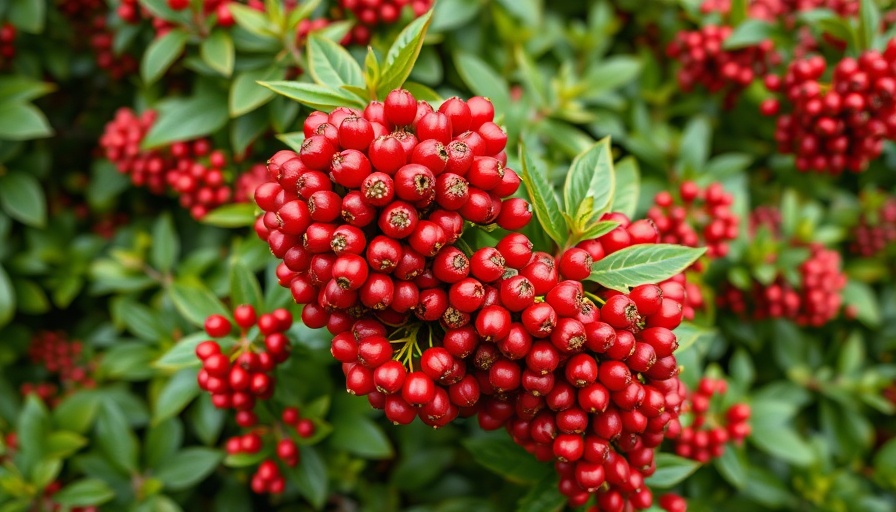
Discovering the Resilience of Hardy Shrubs
Winter can turn even the most vibrant gardens into bleak landscapes, yet certain shrubs have a remarkable ability to not only endure challenging climates but to thrive in them. Homeowners looking to keep their gardens lively during cold months need to consider hardy shrubs that meet their environmental challenges head-on.
Snowberry: The Charming Resilient Warrior
One of North America's beloved natives, the Snowberry (Symphoricarpos albus), is often underestimated due to its delicate appearance. Sporting soft pink flowers and lush green foliage, this shrub is anything but fragile. It is resilient to a variety of soils, drought, and harsh frosts, making it a fantastic choice for diverse climates. Snowberry not only persists beautifully through the seasons, flowering from May to August, but it also produces striking white berries during the winter months. These berries aren't just for show; they provide sustenance for winter birds, turning your garden into a lively winter habitat.
The Snowberry thrives in USDA hardiness zones 3 through 7, requiring only about 1 inch of water per week. Its low-maintenance nature and adaptability make it ideal for foundation plantings or naturalized landscapes.
Winterberry Holly: A Splash of Color Amidst the Gray
Vibrant and native, Winterberry Holly offers an impressive contrast during winter months. Its bright red berries not only deliver a pop of color but also attract local wildlife, enhancing the biodiversity of your garden. This shrub flourishes in wet soils, making it perfect for areas that experience heavy rainfall or standing water.
Hardy enough to survive in USDA zones 3 through 9, Winterberry Holly can grow in sunny or partially shaded spots, adding versatility to your garden design. Consider pairing it with other evergreens to create a visually appealing winter landscape that draws in birds and pollinators alike.
Junipers: Guardians of Tough Terrain
Next on the list is the Juniper, a classic evergreen that stands out for its adaptability. Drought-tolerant and weather-resistant, Junipers can adapt to various soil types, making them invaluable for regions with inconsistent weather patterns. They provide year-round greenery, serving as a backdrop for seasonal flowers and foliage.
Available in a range of sizes and shapes, Junipers can be tailored to suit any landscape, whether sculpted into a topiary or left to grow freely as a ground cover. Their hardy nature ensures they remain an attractive option even when other plants struggle to survive.
Choosing the Right Hardy Shrubs for Your Space
When deciding which shrubs to incorporate into your garden, consider factors such as your local climate, soil conditions, and the level of maintenance you prefer. The benefits of selecting hardy shrubs extend beyond mere aesthetics; they also play a vital role in ecosystem support.
For instance, snowberries and winterberries bolster pollinator health during cooler months, reinforcing the critical balance in local biodiversity. This added layer of functionality can enhance the appeal of your landscaping choices.
The Future of Your Winter Garden
Looking ahead, the trends in landscaping point toward a greater emphasis on climate-adaptable plants, as homeowners recognize the importance of sustainable gardening practices. Hardy shrubs not only resist adverse weather but can also reduce the need for irrigation and serve an ecological purpose.
With climate change posing challenges for gardeners everywhere, investing in robust landscaping will be pivotal. Hardy shrubs like Snowberry, Winterberry Holly, and Junipers not only ensure your garden remains lively but contribute to a healthier planet.
Conclusion: Embrace the Tough and Beautiful
With the right selections, winter can be a season full of potential rather than the end of vibrant gardens. Hardy shrubs like Snowberry, Winterberry Holly, and Junipers are fantastic choices that not only survive but flourish, providing color, function, and ecological benefits.
Don't let winter's chill deter your gardening aspirations! As you prepare for your next planting project, consider these resilient shrubs as your green allies. Start integrating them into your landscape designs and watch your outdoor space transform even during the coldest months. For guidance on selecting expert contractors for planting and maintaining these tough shrubs, visit ProHomeGuides.
 Add Row
Add Row  Add
Add 




Write A Comment